7 Easy Ways to Check .NET Framework Version in 2025
The other day, I wanted to install a new app and stumbled upon several versions—some requiring the .NET Framework. That left me wondering: What .NET Framework version do I have?
Turns out, it’s pretty easy to find out, and I’ll show you a few ways in which you can do it.
Besides helping you run compatible apps, knowing your .NET version can also come in handy when troubleshooting errors, developing software, or keeping your system secure and up to date.
Here’s how you check:
- Use PowerShell
- Checking Manually Through Windows Features
- Use .NET Version Detector
- Try NET Version Check
- Use the Registry Editor
- Use the Command Prompt
- Check Using Visual Studio
How to Detect .net Version
1. Use PowerShell to Detect .NET Versions
If you’re comfortable using PowerShell, here’s a simple command to list installed .NET Framework versions:
gci 'HKLM:\SOFTWARE\Microsoft\NET Framework Setup\NDP' -recurse | gp -name Version -EA 0 | where { $_.PSChildName -match '^(?!S)\p{L}'} | select PSChildName, Version
This command will show you a basic version list, but it won’t detect versions 1.0 or 1.1 and doesn’t display service pack info.
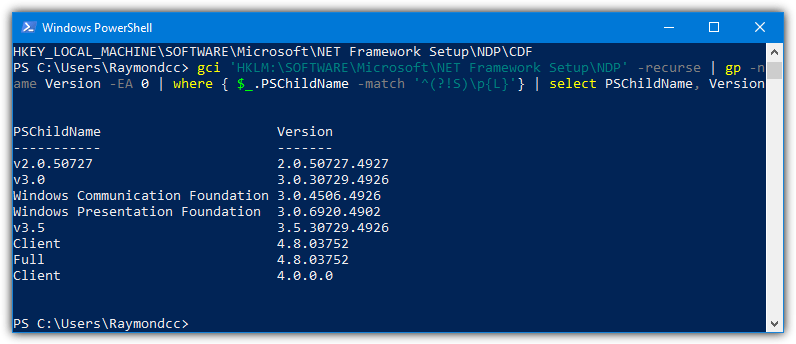
If you want something more user-friendly, try using a ready-made PowerShell script that clearly displays all versions, from .NET 1.0 to 4.8.
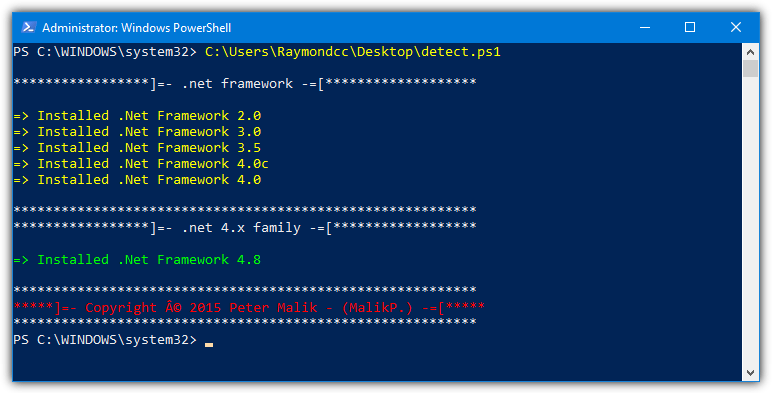
Download .NET Framework Installed Versions Getter
2. Checking Manually Through Windows Features
You can manually check the installed versions of Microsoft .NET Framework in a few ways.
One method is by going to “Programs and Features” or Add and Remove Programs in the Control Panel. However, this method might not always be accurate, as uninstall entries could be removed from the registry, or old versions might be left over. Additionally, built-in versions of .NET that come with the OS won’t show here.
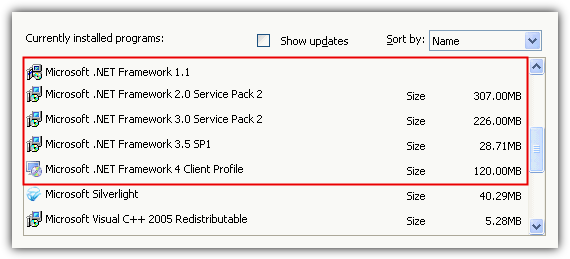
Another manual way is by checking the folders where the .NET program files are stored. These folders are usually found in C:\Windows\Microsoft.NET\Framework and C:\Windows\Microsoft.NET\Framework64 for 64-bit systems. Hovering over the folders shows their size (we used Free Commander below to check sizes easily).
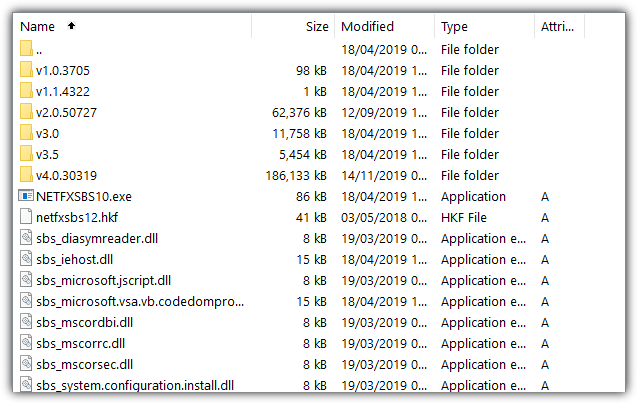
The folder for version 1.0 and 1.1 might be empty, meaning they aren’t installed. The v4.0.30319 folder can be tricky because it could contain any .NET 4 version from 4.0 to 4.8. To find the exact version, open the folder and hover over a DLL or executable to see its info tip with the installed version.
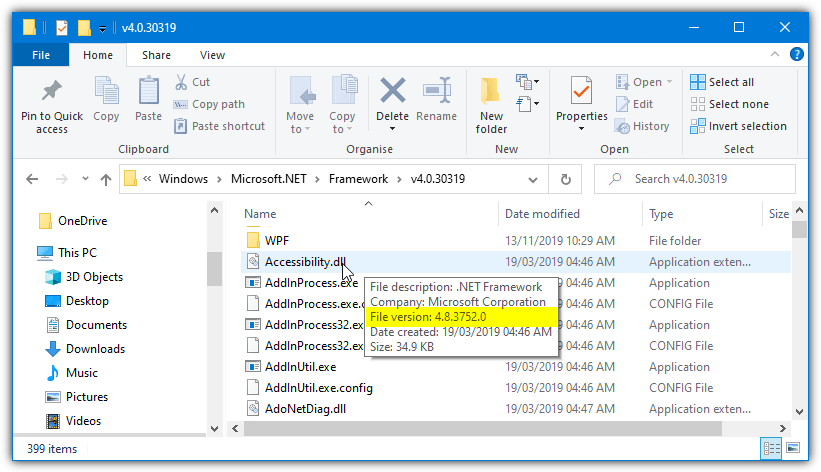
While this method isn’t the most precise, it gives you a rough idea of what .NET versions are installed using just Windows File Explorer.
3. Use .NET Version Detector
ASoft .NET Version Detector is a small and lightweight portable tool that shows all the different versions of the .NET Framework installed on your machine. If a version isn’t installed, the program provides easy links to download the missing version from Microsoft’s website, as well as the Software Development Kit (SDK) for each version.
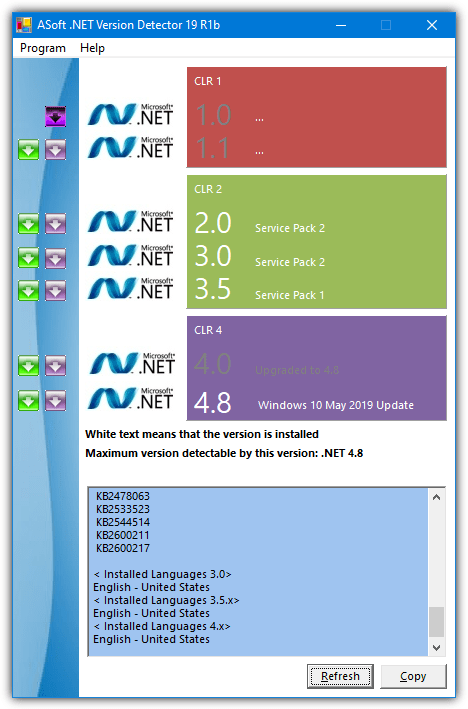
The tool shows installed versions with white text. You can click the logo next to each version to open its install directory. The log box at the bottom displays the versions, updates, and their folder locations, including 32bit/64bit. You can copy all this information to your clipboard by using the copy button.
To see which versions are standard for each operating system, go to Help > .NET Version History. ASoft .NET Version Detector checks versions 1.0 to 4.8 and works on Windows 2000 and later.
Download .NET Version Detector
4. Try NET Version Check
Though a bit outdated, NET Version Check is still effective. When tested, it detected the latest .NET Framework 4.8. Make sure to run it as Administrator, even if you already have admin rights, or it won’t show the version numbers.
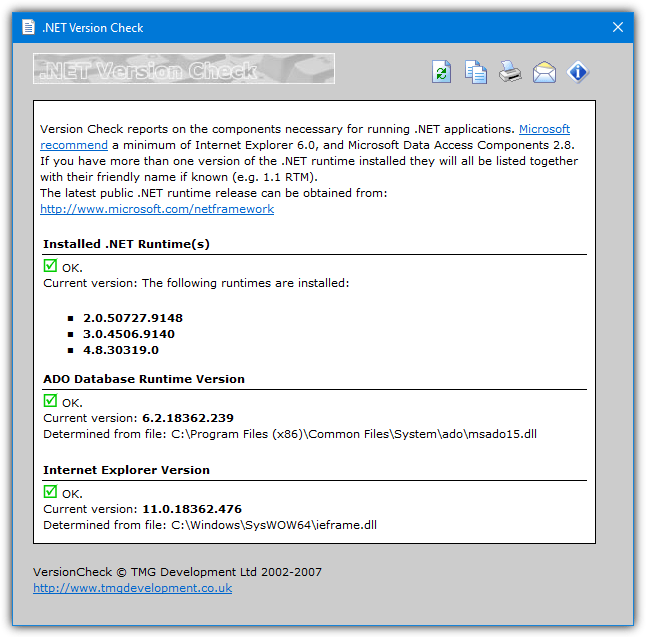
This tool also checks the version of Internet Explorer, which can be useful for older systems. It offers options to copy the info to the clipboard, print it, or email it. Inside the zip file, there’s a command-line version that can be used in batch files and doesn’t require administrative privileges.
The GUI and command-line versions provide a version number, which might not be as easy to read. However, it still gives you useful info for troubleshooting and identifying installed versions.
5. Use the Registry Editor
You can check the installed .NET versions through the Windows registry. This method can show you the exact version numbers of the installed frameworks.
To do this:
- Press Win + R, type regedit, and press Enter.
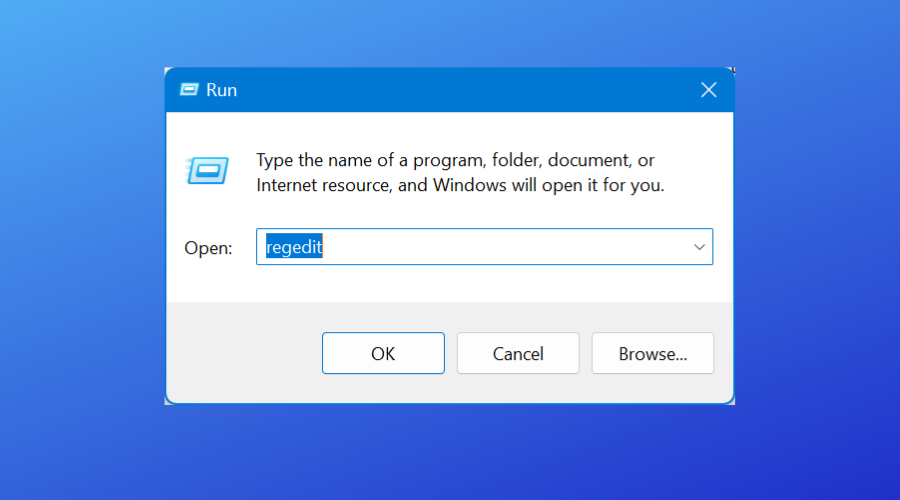
- Navigate to the following path: HKEY_LOCAL_MACHINE\SOFTWARE\Microsoft\NET Framework Setup\NDP
- Under this registry key, you’ll find subkeys for each version of .NET installed on your system. For example, v4 for .NET 4.x or v3.5 for .NET 3.5.
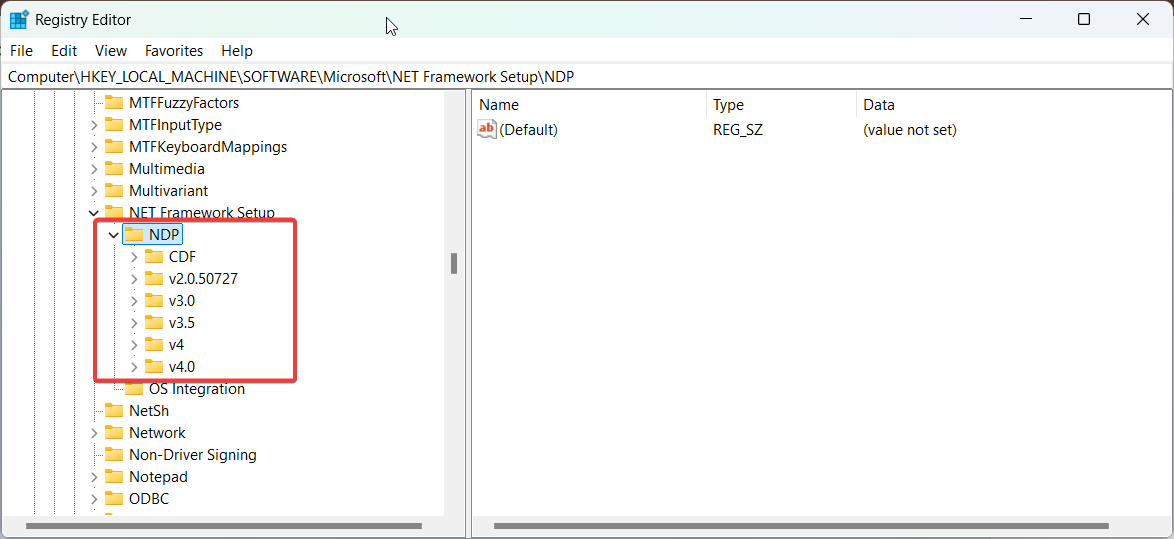
This method requires caution since making changes to the registry can cause system issues. Only read the information without making any changes.
6. Use the Command Prompt
If you’re comfortable with command-line tools, you can use the Command Prompt to check for installed .NET versions:
- Open Command Prompt with Admin privileges.
- Type the following command: dir /b /ad C:\Windows\Microsoft.NET\Framework This will list all directories corresponding to installed versions of .NET Framework.
- If you have a 64-bit system, use: dir /b /ad C:\Windows\Microsoft.NET\Framework64
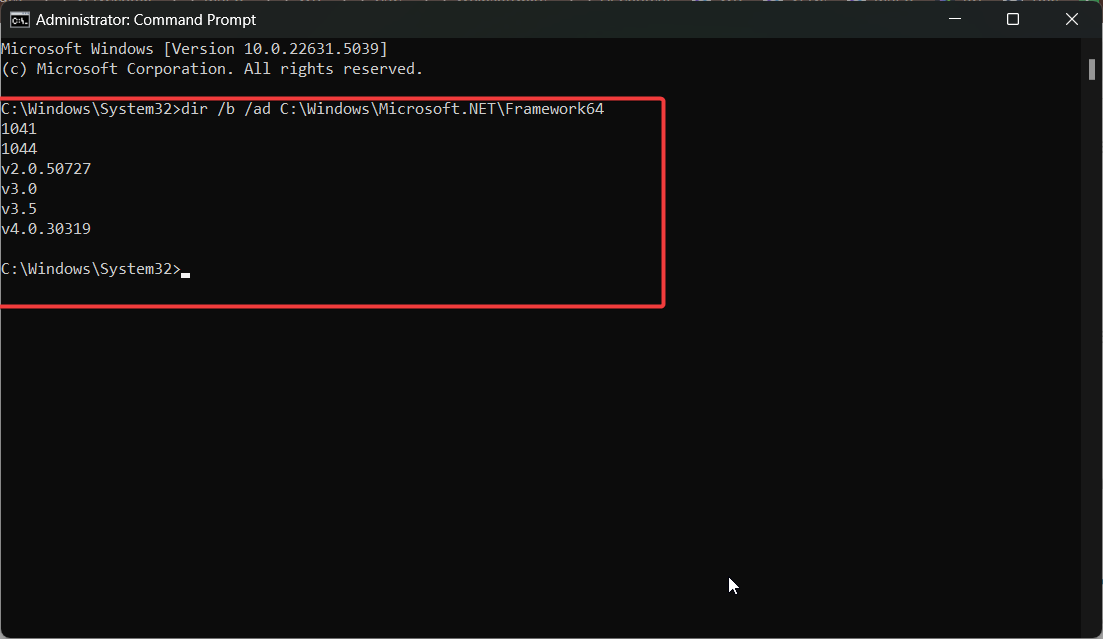
This method is quick but only shows the folders associated with installed versions, so it’s less detailed compared to other methods.
7. Check Using Visual Studio
If you have Visual Studio installed, it also offers a way to check which .NET versions are available on your system:
- Open Visual Studio.
- Go to Tools > Options.
- Navigate to Projects and Solutions.
- Create a new project.
- You’ll see the installed versions of .NET Framework and .NET Core.
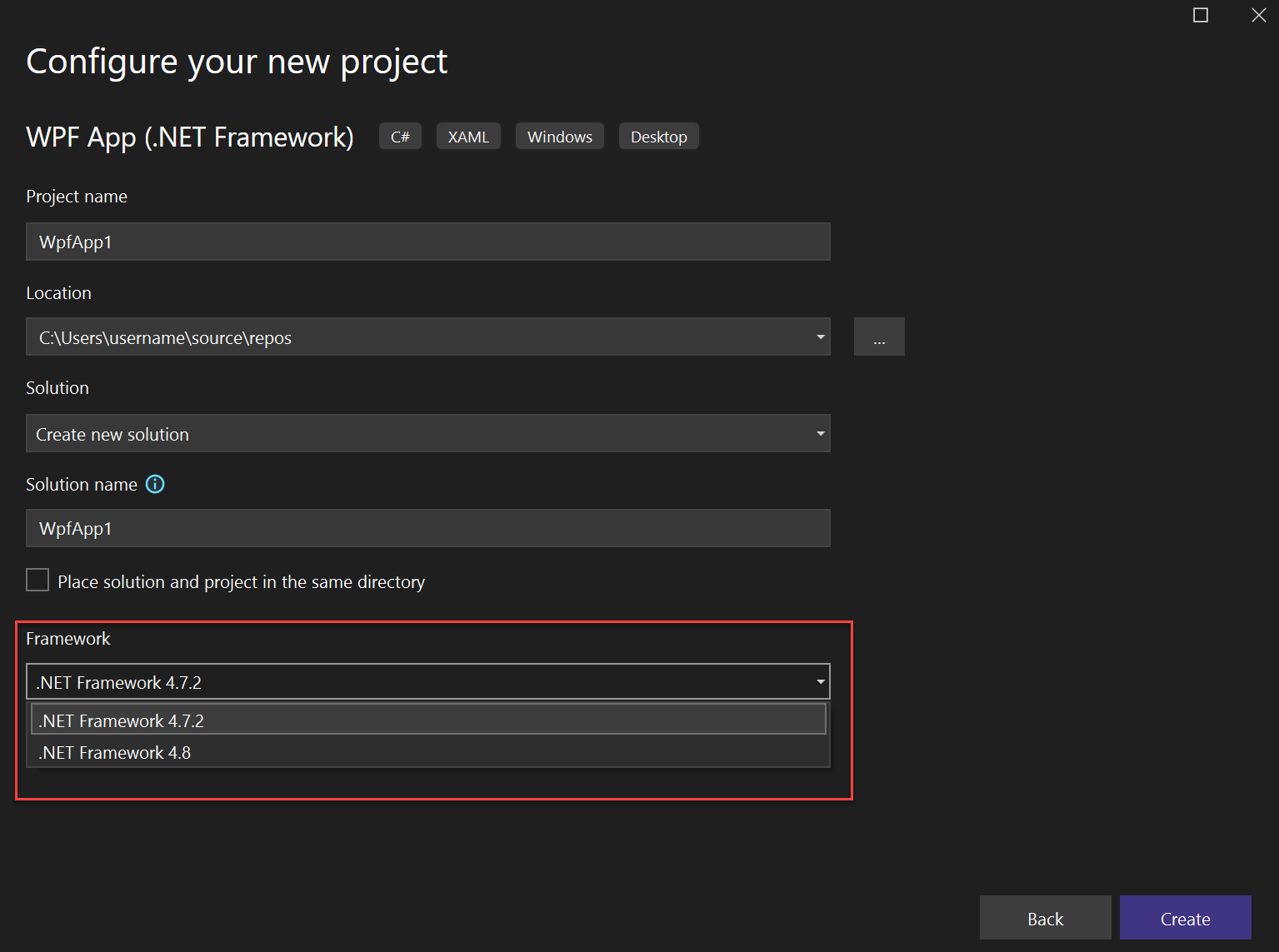
This method is particularly useful if you’re a developer or using .NET for software development.
Knowing which .NET version is on your system is key to making sure apps run smoothly and fixing any issues that pop up. If you’re dealing with multiple versions or need to uninstall .NET, tools like Aaron Stebner’s Cleanup Tool can help. Check out how to uninstall .NET Framework if you’re having trouble with that.
If you’re seeing a bunch of versions in “Add or Remove Programs,” find out how to manage multiple .NET versions.
And if you’re not sure your installation is right, try the .NET Framework Setup Verification Utility. Keeping everything updated will save you a lot of headaches down the road!
I have created a windows “remote diagnostics tool” that will detect the correct “.net core runtime” and “.net framework versions” on a remote pPC on the network.
It can do a lot of other things too : Its free and you can download from my website : appslife-rdt.appspot.com
There are a couple of free programs which will also give you information in respect to installed .NET frameworks.
PCFerret Pro: pcferretpro.com
Speccy: ccleaner.com/speccy
Both of these have been around for years.
Hope this helps.
Try this
dir C:\WINDOWS\Microsoft.Net\Framework\v* /O:-N /B
Thank you for sharing this information!!
Thanks so much, works perfectly and even saw my .NET 4.8.
Or you can execute PowerShell script
github.com/peterM/Net_Framework_Installed_Versions_Getter
Thanks alot.
On Windows 8.1 x86 clean install:
1. Installed .NET Framework 4.6.2 and Raymondcc .NET Detector could detect the version but v4.5 was gone I guess cause the program showed as not installed.
2. Afterwards I installed .NET Framework 4.7 but oddly Raymondcc .NET Detector couldn’t detect any version anymore, except v3.5, v2.0.
Thanks for the feedback.
1. v4.6.x is an update to v4.5 and replaces it on the system, so you can’t have both 4.5 and 4.6.2 installed at the same time.
2. The tool was last updated in April when .NET 4.7 was only available for Windows 10 Creators update and the standalone installer hadn’t been released. The tool has now been updated to detect the installer version of 4.7. Do note that 4.7 is also a replacement update for 4.5 or 4.6, so you will get only 4.7 and not 4.6.x or 4.5.x.
Great job indeed
Dear Dale Chen,
This is very good offer. Thanks for this beautiful comment.
PowerShell solution provided by Microsoft: gallery.technet.microsoft.com/How-to-determine-versions-d3669799
To find .NET Framework versions by viewing the registry (.NET Framework 1-4)
On the Start menu, choose Run.
In the Open box, enter regedit.exe. You must have administrative credentials to run regedit.exe.
In the Registry Editor, open the following subkey: HKEY_LOCAL_MACHINE\SOFTWARE\Microsoft\NET Framework Setup\NDP.
(taked from msdn.microsoft.com/en-us/library/hh925568(v=vs.110).aspx)
this doesnt work on the latest windows versions
thanks natell!
wmic /namespace:\\root\cimv2 path win32_product where “name like ‘%%.NET%%'” get version
it will show the installed version
Another way to detect is using the “Microsoft Web Platform Installer” which will exactly show the Framework versions currently installed as well as the ability to download and install versions from it instantly.
Nice work,
Can you please upgrade this tool to detect .NET Framework 4.5.1 and 4.5.2
Currently, I need to check the minor version as per my product prerequisites, would be more beneficial if we get to know the Minor versions using this tool
If you put your cursor over 4.5 it will show you the version. Mine says 4.5.50938
Thank you so much for the detector app! <3
Thank you for the Raymondcc .NET Detector app. It was exactly what I needed to fix an “Unhandled Exception” error by helping to install the missing .NET Framework(s) ! :-)
Thanks a lot for Raymondcc .NET Detector. Very quick, very easy, very helpful,
works well fantastic
Try this
dir %windir%\Microsoft.NET\Framework/AD
wmic /namespace:\\root\cimv2 path win32_product where “name like ‘%%.NET%%'” get version
Thanks a lot. Very useful for getting results from users.
Thanks for the fantastic tool!
Fantastic answer
Thanks, that’s helping a lot.
worked thanks!
Thanks a lot
Woww. I’ve never thought about this. Thanks a lot.
thanks raymond, i was trying to use quickpwn and didn’t realize i needed .net so thanks for letting me know and helping me.
Thanks, I was not sure what version I had, as I know I had got a new one but now I do!!!
Many thanks. ;)
Thanks dude. this work very fine.
useful tool man
thanks
Woohoo… excellent job Raymond…makes my life easier when checking my customers’ PC(s)
Thanks Ray..
very useful.. Thank you Ray~
thanks Raymond